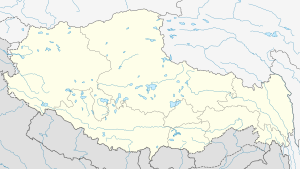Thok Jalung
Thok Jalung[1] was a goldfield in Tibet[2] that gained international attention upon its discovery by the west.[3][4]
| Location | |
|---|---|
 Thok Jalung Location in Tibet Automomous Region | |
| Tibet Autonomous Region | |
| Country | People's Republic of China |
| Coordinates | 32.24°N 81.37°E |
Thok Jalung was one of many goldfields that stretched from Lhasa into western Tibet, north of the Tsangpo River watershed.[5] Situated on the Changtang, 16,330 feet (4,980 m) above sea level,[6] Thok Jalung was the highest altitude goldfield in the world[7] and at the time was believed to be the highest altitude in the world inhabited all year round.[5]
Thok Jalung was first visited by a non-Tibetan on 26 August 1867 when the pundit Nain Singh Rawat, who was secretly surveying Tibet, visited the mines.[8] He would later say that Thok Jalung was the coldest place he had ever visited.[9] It was not until 1906 that the first European visited Thok Jalung.[5]
Thok Jalung was very productive and Nain Singh reported seeing one nugget weighing nearly 2 pounds (0.91 kg).[7] The goldfield was about a 1 mile (1.6 km) long,[4] with a small stream running through the field, used to wash the gold out of the soil.[10]
Miners lived in yak-hair tents pitched in holes two or more metres below the ground. There were about 300 miners during the summer and over 6 000 during winter, as frozen ground was less likely to collapse.[7] As in many cases the miners' families were also staying onsite, one author has suggested a winter population of 20 000 at Thok Jalung.[11]
Tibetans believed that gold nuggets contained life and were the parents of gold dust. If a nugget was excavated in error from Thok Jalung it was immediately reburied.[12]
References
- "Thok" is Tibetan for "gold or goldfield", while "Jalung" was the name of the area. Waller, p. 108.
- Hopkirk, p. 38.
- "Progress of Modern Discovery", Queanbeyan Age, 13 May 1869, p. 4.
- "Gold-Digging in Thibet", Westport Times, 8 May 1869.
- Waller, p.109.
- Markham, p. xxiv.
- Hopkirk, p. 40.
- "Nain Singh Rawat's 187th birthday". Google. Alphabet. Retrieved 24 April 2019.
- Hopkirk, p. 39.
- Montgomerie, p. 189.
- Cooley, p. 360.
- Hopkirk, p. 37.
Sources
- Cooley, W. (1876) Physical Geography: Or The Terraqueous Globe and Its Phenomena, Dulau and Company.
- Hopkirk, P. (1982) Trespassers on the roof of the world, John Murray: London. ISBN 0719539382.
- Markham, C. (1999) Narratives of the Mission of George Bogle to Tibet and of the Journey of Thomas Manning to Lhasa, Asian Educational Services: New Delhi. ISBN 9788120613669.
- Montgomerie, T. (1869) "Report of the Trans-Himalayan Explorations during 1867", Proceedings of the Royal Geographical Society of London, Vol. 13, No. 3 (1868 - 1869)
- Waller, D. (2015) The Pundits: British Exploration of Tibet and Central Asia, University Press of Kentucky: Lexington, Kentucky. ISBN 9780813149042.